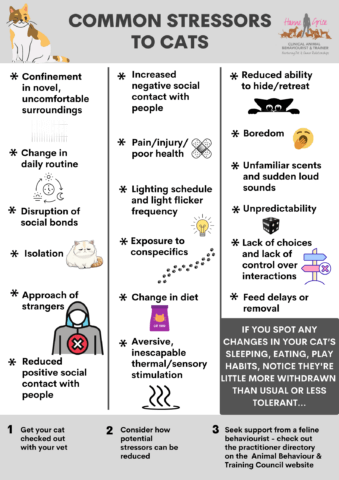
Data suggests even stoic cats can have elevated levels of adrenaline, noradrenaline, dopamine, and other stress hormones, and that chronically stressed cats often feign sleep. So until the cat exhibits obvious signs that attracts the owner’s attention, such as going off their food or reduced movement, the cat may be internalising his or her anxiety.
That means, unless owners are highly skilled at detecting the signs of stress in cats and understand their body language, there could be a real risk of poor assessment regarding the animal’s welfare. For example, cat stress and urinary problems are strongly associated; stress can lead to high levels of cortisol which can reduce the effect of the immune system.
One of the ways we can reduce the likelihood of cats internalising their anxiety, therefore reduce the risk of subsequent health issues, is to better understand common stressors for cats.
The info graphic highlights some of these including loud noises, unfamiliar scents in the home, changes of routine, boredom and so on.
As with any animal, if they are unable to exhibit normal behaviours this may lead to physiological and behavioural changes.
So, if you spot any changes in your cat’s sleeping, eating or play habits, or have noticed they may be a little more withdrawn than usual or less tolerant of people, do get them checked out with your vet and consider how potential stressors can be reduced. That way we can help to have a happier and healthier cat.
©Hanne Grice
Learn more about our classes

Get Hanne's Book
Playing With Your Dog will help any dog owner work out the games that are best suited for their pet to play throughout his life, from puppyhood to old age. The book also shares some tricks for all ages, group activities, and recommended toys that dogs will enjoy.

























